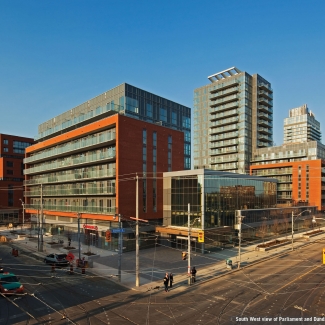Diamond Schmitt Architects, with Graziani + Corazza Architects Inc., NAK Design Strategies
One Cole is the first condominium to be completed in the 15-year Regent Park Revitalization Plan. This LEED Gold candidate connects to its urban setting with two mid-rise towers, three-storey townhomes and a variety of street-level retail that features a glazed atrium. Residents have a 21,500-square-foot green park on the third floor roof where ample depth of soil ensures trees will mature. Thoroughly contemporary in design, these masonry and glass buildings incorporate the best practices of the city’s medium-density residential areas, with an emphasis on individual street entrances for units and the inclusion of porches and balconies, ensuring ‘eyes on the street.’





“One Cole is playing admirably its role as landmark and gateway for the new Regent Park, the redevelopment of the oldest social housing project in Canada.
The rather large mass is allocated in three well-distributed volumes. The project integrates a grocery store and creates a very important public realm component at Dundas and Parliament with the plaza and the atrium/wintergarden with a spectacular “living wall”.
The purposefully restrained architectural vocabulary features simple treatment and extensive use of the red brick, emphasizing its residential character, integrating well with the surrounding area, and setting the tone for the balance of Regent Park’s forthcoming development.
The project is an examplar of the sustainable and healthy approach of Regent Park – part of the district energy system, providing outdoor amenity spaces as green roof, community garden plots, and numerous green building features.
One Cole is a demonstration of a project and buildings that contribute exemplary to the formation of a community, to the city’s vitality and liveability, and continues Toronto’s tradition of socially responsive contextual modernism.”